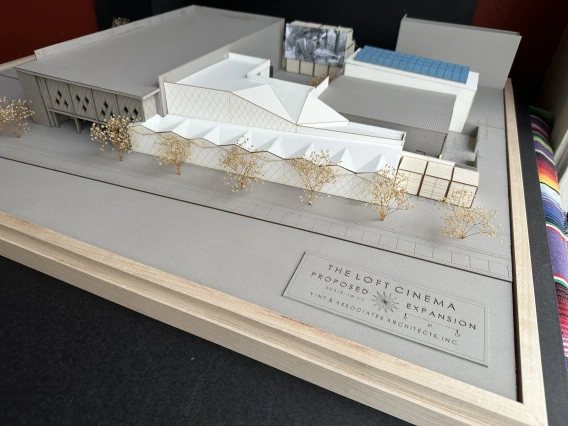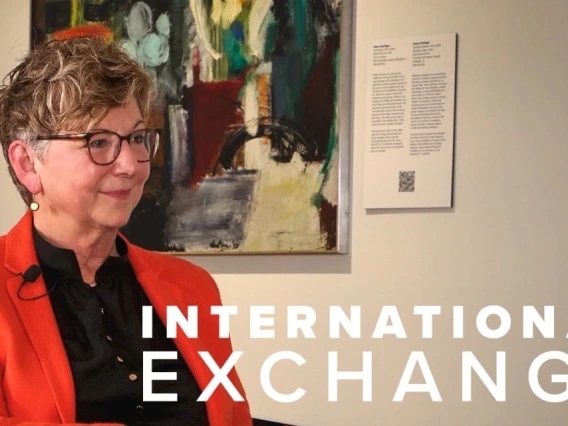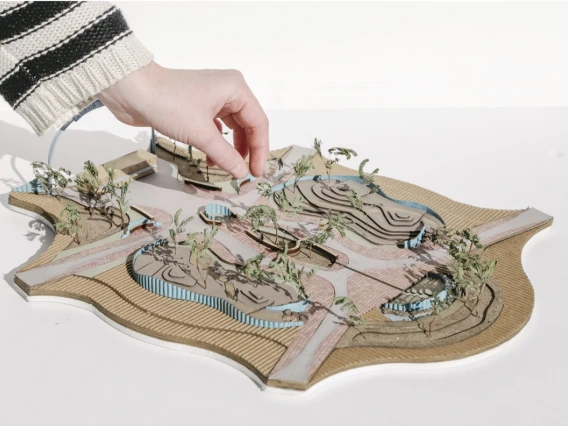From Hedgerows on the Prairie to Footsteps on the Moon: A World Heritage Site Evaluator’s Journey
CAPLA Thought Leadership

Nancy Pollock-Ellwand (right) with ICOMOS colleague and Irish archaeologist Gabriel Cooney and the President of the Sámi Parliament (left) in northern Norway, the site of prehistoric burial grounds. Photo courtesy Sámi Parliament.
By Nancy Pollock-Ellwand, CAPLA Dean
The most spirited exchanges I have had with colleagues over the years have occurred around heritage conservation. Why? Because heritage matters!
Heritage is a word that covers a range of elements, both natural and cultural. Whether we are talking about landscapes, objects, traditions, structures, cities, artwork or even cave dwellings, heritage contributes to shared identity, reflects values and holds memories. Importantly it also provides a perspective that can lead to a more profound understanding of each other.
Since I first began my career by working on a project to restore a 1914 prairie homestead decades ago, the conceptual foundation of the heritage conservation field has shifted dramatically. That project began with the now-antiquated directive to hold a cultural landscape as a static artifact in a museum—where mature hedgerows were moved three feet to accommodate a foot path and heirloom vegetables planted and tended. Now the challenges and conversations are very different, with a wider diversity of heritage resources being considered and a multiplicity of perspectives to consider.
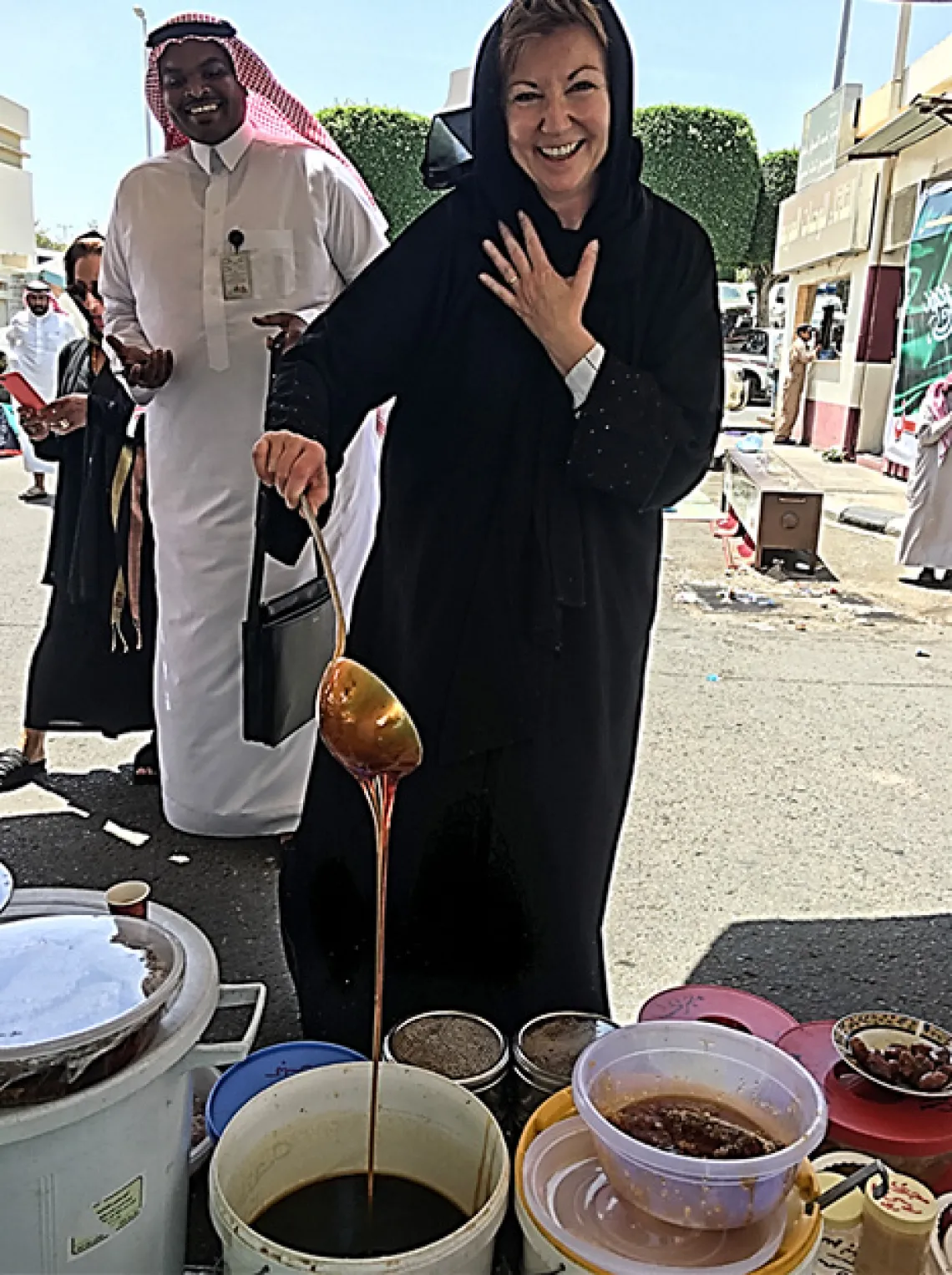
Nancy Pollock-Ellwand tastes local honey from a vendor at a rural market in southwest Saudi Arabia during a trip to examine the mud tower houses of Rijal Alma. Photo courtesy Nancy Pollock-Ellwand.
When co-charing the World Heritage Evaluation Panel for the International Council of Monuments and Sites (ICOMOS), I was impressed by the passion of the discussions among heritage experts from around the globe. ICOMOS is an international, non-governmental group that advises UNESCO on the conservation of monuments and sites around the world. It represents a network of specialists, ranging from architects, planners and historians to archaeologists, engineers and sociologists. The organization helps to develop international policy, advances restoration approaches and recommends new World Heritage sites. Countries spend years and millions of dollars preparing these nominations because their value is seen in terms of enhancing a nation’s world reputation and recognition. The World Heritage site designation—or inscription—tells the world that the natural or cultural resource is valued not only within the boundaries of that country but universally by all humanity. Pragmatically, these World Heritage inscriptions define sovereignty for some, bring new resources to protect the heritage, reinforce political will to impose more protections, attract locals back to a region that may have lost its economic opportunities and attract new dollars from tourism.
In our World Heritage site evaluations, opposing perspectives meet each other in multiple languages: Euro-centric and non-western, rural and urban, vernacular and aristocratic, indigenous and colonizers. Each year there are 20 to 30 nominations deliberated within a panel of experts and in conversation with representatives of different state parties. Through two separate, week-long sessions during the year the World Heritage Evaluation Panel arrives at recommendations that are forwarded to the World Heritage Committee, which makes the final decisions. There are various outcomes: to inscribe as a new World Heritage site, not to inscribe, to refer it back to a country for more information or to defer the nomination for major modifications.
Heritage in this global setting is officially judged for its “Outstanding Universal Value,” which is defined in the World Heritage Convention. A site’s universality is gauged by its integrity and authenticity and then evaluated against similar sites from around the world in a comparative analysis. The site’s significance can be described across 10 possible criteria that represent the range of human expression and natural values—from a masterpiece of human genius or a seminal development in landscape design to a place associated with artistic works or a superlative natural phenomena of exceptional beauty.
The nominations presented by a state-sponsored organization must demonstrate how the significance of the proposed site reaches beyond its national boundaries yet is also supported by local communities, protections and management measures.
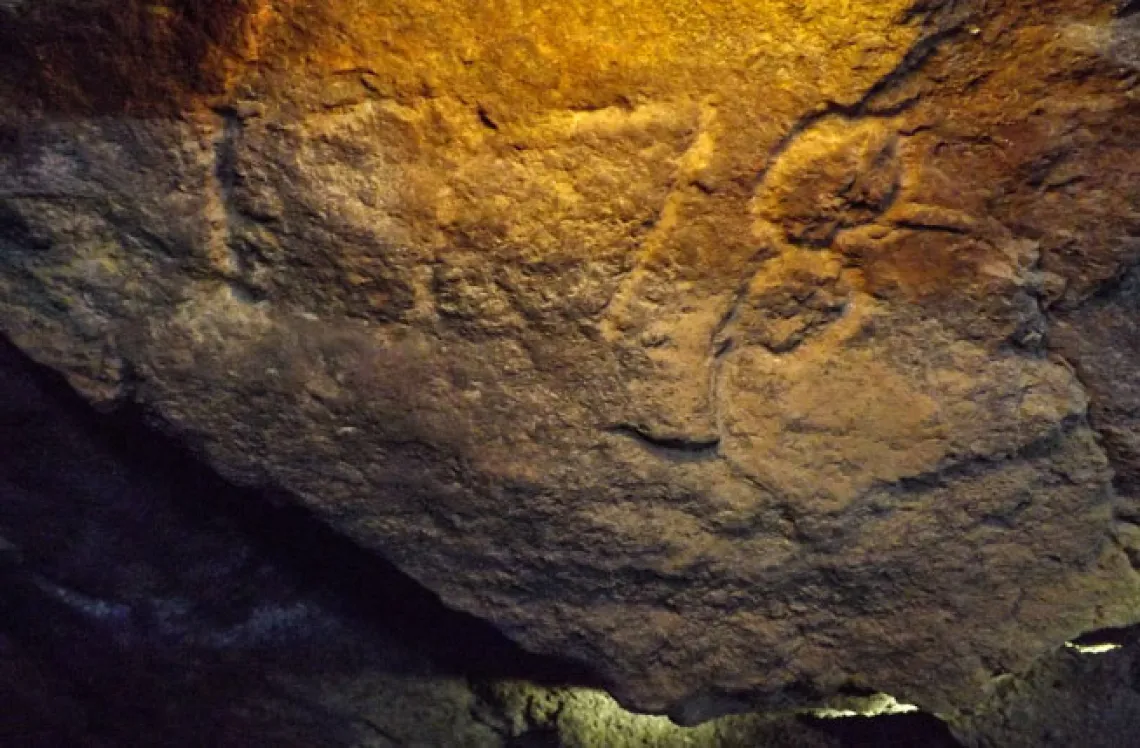
The year "1778" etched into a hand-dug tunnel deep below the mineral-rich Ore Mountains of Germany’s Erzgebirge/Krušnohoří mining region. Photo by Nancy Pollock-Ellwand.
In my work on behalf of ICOMOS as a “mission expert,” I have traveled around the world. Each site is unique but always holds deep resonance. Each site an extraordinary expression of human ingenuity, resilience and wonder. My visits to sites as a mission expert are intended to assist the nominating state organization in crafting the best package possible to convince ICOMOS of that “Outstanding Universal Value.” These missions have provided enduring experiences and memories, underlining the commonality of the very human connection to place. In each encounter I learn more about cultures very different from my own—and I am always cognizant of what a privilege this is.
Here is a sampling of those transformative experiences:
In southwest Saudi Arabia I tasted local honey from a vendor at a rural market (facing the impossibility of getting some of that gooey liquid into a bottle!) when I traveled with a two-woman team to examine the mud tower houses of Rijal Alma.
In a hand-dug tunnel deep below the mineral-rich Ore Mountains of Germany’s Erzgebirge/Krušnohoří mining region, I traced my fingers across 1778, a date etched on the wall. There I was transported back to the dark, damp, cold and impossibly difficult task of the miners who marked each year of their advance in the tunnel, just three feet annually, with a date.
In the Nagasaki region of Japan I learned the secret history of the Hidden Christian Sites. It is a history of enduring strength of faith under incredible duress, a faith that still draws communities together as they gather to cook communally, with local produce and fish—and feed along the way an appreciative visitor such as myself.
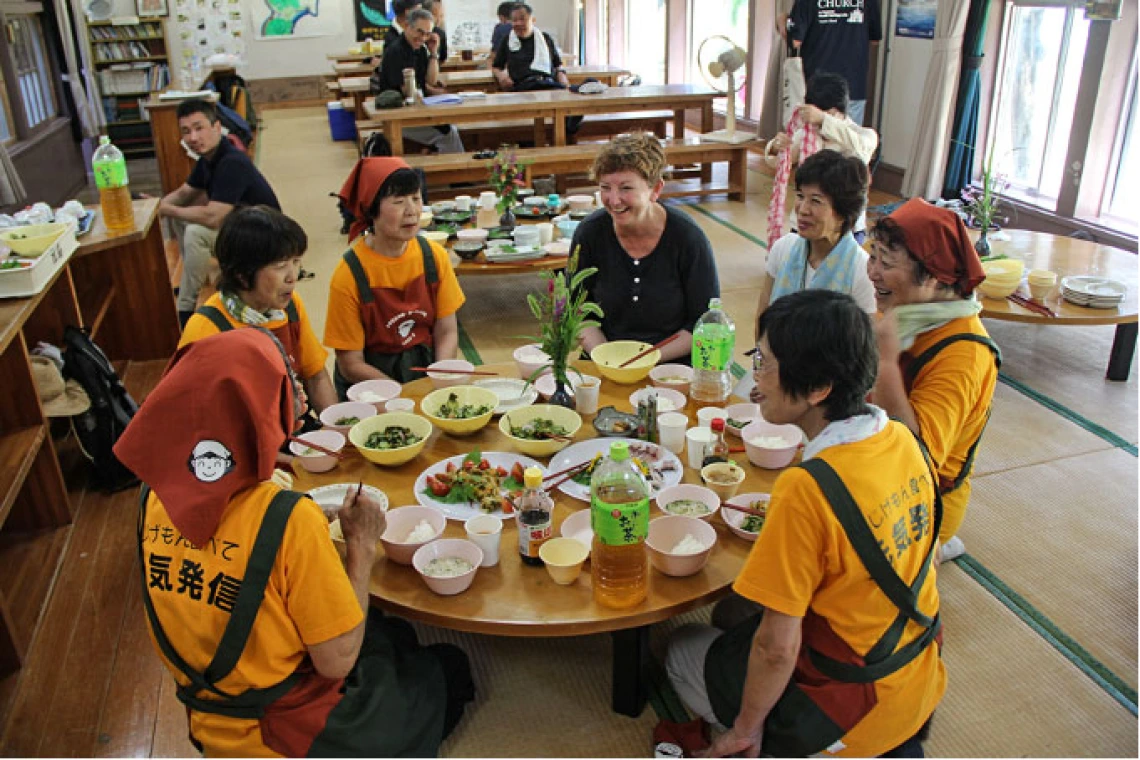
Nancy Pollock-Ellwand enjoys a meal with a community of faith at the Hidden Christian Sites in the Nagasaki region of Japan. Photo courtesy Nancy Pollock-Ellwand.
My latest trip took me to the Arctic landscape of the Sámi people of northern Norway. They trace their connection to land through their relationship to the reindeer they have herded and harvested for centuries. In that northern landscape I saw the pride of language, ancient hunting methods, reconciliation and land rights.
My fascination with World Heritage sites persists as the field continues to evolve and challenge world views. Today, discussions are centered on much more complex subjects, such as the perservation of linguistic rights and ethnobotanical knowledge in ǂKhomani Cultural Landscape, South Africa; memorializing painful and tragic memories (e.g., Auschwitz Birkenau German Nazi Concentration and Extermination Camp, 1940-1945, Poland); marking recent, ongoing or unresolved conflicts (e.g., Ancient City of Aleppo, Syria); and sites that are deteriorating at such a fast rate, because of climate change, that they are placed on the UNESCO Heritage at Risk list as soon as they are inscribed (e.g., Nan Madol: Ceremonial Center of Eastern Micronesia).
How (and where) this evolution of World Heritage selection manifests itself, one can only speculate. For example, extraterrestrial sites are now being contemplated for protection. Consider the site of the 1969 moon landing by Apollo 11: it raises questions of sovereignty and the impacts of tourism. The World Heritage Evaluation Panel will soon be confronted with developing protection techniques suited to the face of the moon.
My passion for heritage conservation continues as practice and theory evolve and as the ardent debates persist—whether a prairie hedgerow, the surface of the moon or somewhere beyond.
Learn more about—and prepare yourself for a new career in—heritage conservation with CAPLA's innovative Graduate Certificate in Heritage Conservation or our Master of Science in Architecture and Master of Science in Urban Planning programs.

